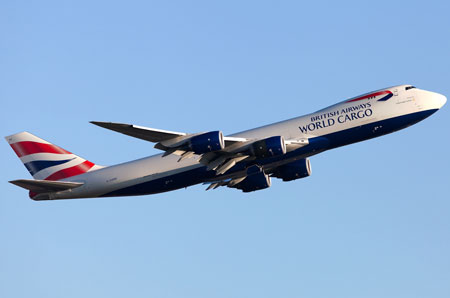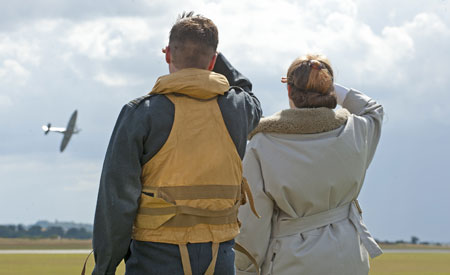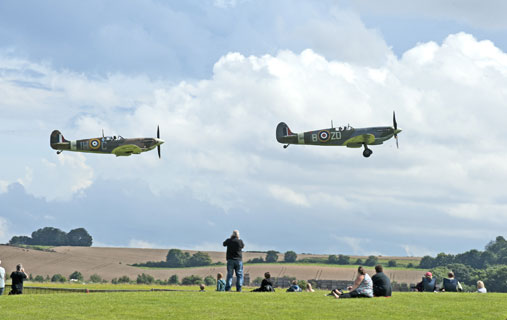The Spring Air Show (Sunday 26 May) commences its flying programme in superb style with the first-ever display of the Eagle Squadron, a historic four-ship comprising a Hawker Hurricane, Supermarine Spitfire, Republic P-47 Thunderbolt and North American P-51 Mustang.
P-51C Mustang Princess Elizabeth was shipped over from the USA specifically for the Spring Air Show.
The Hurricane and Spitfire have received new paint schemes especially for this display.
The Eagle Squadron will fly in four-ship formation, as pairs and also in an evocative display alongside B-17 Flying Fortress Sally B.
The four aircraft comprising the Eagle Squadron represent the history of American pilots serving in Europe during the Second World War. Spitfires and Hurricanes were flown by American volunteers in the Royal Air Force prior to the United States officially entering the war. Soon, these American recruits were formed into their own squadrons within the RAF, known as Eagle Squadrons. The display is named in their honour, with the P-47 Thunderbolt and P-51 Mustang representing the massive effort by the United States Army Air Forces during the latter half of the conflict.
The aircraft will be piloted by Dan Friedkin, Ed Shipley, Steve Hinton and Paul Bonhomme. Americans Dan, Ed and Steve are best known as the Bremont Horsemen Flight Team and have performed spectacular P-51 Mustang displays at the Flying Legends Air Show and at events around the globe. Paul Bonhomme is a Red Bull Air Race pilot and has displayed historic aircraft at over 700 air shows to date.
Eagle Squadron lead Dan Friedkin has worked closely with aviation photographer and historian John Dibbs to develop and manage the concept. Dan said “It is a great honour to present the Eagle Squadron, a vivid aerial tribute to the 70th anniversary of American involvement in the Second World War. We look forward to debuting this tribute, flying in the vintage fighters which once soared over Europe, in memory of the brave aces who piloted them and the greater Anglo-American air power alliance.”
The Spring Air Show takes place on the 70th anniversary of King George VI and Queen Elizabeth visiting RAF Duxford to welcome the 78th Fighter Group of the United States Army Air Forces to Great Britain. From its arrival at RAF Duxford in April 1943, the 78th Fighter Group flew P-47 Thunderbolts on bomber escort duty, switching to P-51 Mustangs in December 1944.
Richard Ashton, Director of IWM Duxford, said “I’m thrilled that the Eagle Squadron will be presenting its debut flying display as the centrepiece of our flying programme at the Spring Air Show. The Eagle Squadron represents, in one flying display, Duxford’s Second World War American air force history, from the Eagle Squadron volunteers flying Spitfires and Hurricanes with the RAF, to the 78th Fighter Group flying Thunderbolts and Mustangs.”
Each Eagle Squadron aircraft features the paint scheme and markings of American pilots whose inspiring wartime stories stand the test of time.
Hawker Hurricane AE977 G-CGTK has been painted as P3886 for the show, with coding UF-K, representing a Hurricane of No.601 (County of London) Squadron. P3886 was flown by Americans William M L Fiske III and Carl R Davis.
Billy Fiske – No.601 (County of London Squadron), Royal Auxiliary Air Force – was one of only 11 American pilots flying in the Battle of Britain. Flying Hurricanes from Tangmere, he was credited as a natural fighter pilot and was popular amongst his peers. His wartime career ended when a German gunner put a bullet through his reserve fuel tank. His engine cut out immediately, but knowing that his Hurricane was essential to the war effort, he elected to nurse the aircraft back to Tangmere rather than bail out and save himself.
Billy made it back to Tangmere, skimming over the hedge in the midst of an enemy bombing raid on the airfield. He landed safely, but moments later his aircraft exploded, trapping him inside. He was rescued from the burning cockpit, suffering severe burns to his hands and face. Later that night in hospital, he was reported to be in great spirits, but only 48 hours later, he died from shock resulting from his severe injuries.
Billy was buried close to Tangmere, with his tombstone bearing the epitaph ‘He died for England’. The following year, the British government unveiled a plaque to his memory in the crypt of St Paul’s Cathedral, enscribed ‘An American citizen who died that England might live.’ Only 29 years old, Billy Fiske was the first American to die in service with the RAF during the Second World War.
Carl Davis – No.601 (County of London) Squadron, Royal Auxiliary Air Force – had his first taste of combat on 28 November 1939, flying a Blenheim during the successful Borkum Raid, which attacked the Luftwaffe seaplane base on the Frisian Islands. Five seaplanes were destroyed during the surprise attack with no damage to the Blenheim squadron.
In March 1940, the squadron received its first Hawker Hurricanes. On 11 July 1940, Carl Davis made his first combat kill, shooting down a Bf 110. Having joined the RAF much earlier than most American volunteers, Carl’s experience served him well during the Battle of Britain. His final tally of nine-and-a-half aerial victories made him a Double Ace and equaled those claimed together by the other ten Americans who saw combat during the Battle of Britain. In August 1940, he was awarded the Distinguished Flying Cross.
On 6 September 1940, 601 Squadron were sent out on a final scramble before taking some much-needed leave. Carl had flown missions consistently for 12 weeks. That morning, the squadron was taken by surprise by a large formation of Bf 109s over Kent. Carl’s aircraft was one of four Hurricanes destroyed in the attack. His aircraft broke in two as it plummeted towards the ground. He crashed, inverted, into a back garden in the village of Matfield.
The police officer who first arrived at the scene discovered Carl strapped into his burnt and broken aircraft with his feet still on the rudder bars. Carl Davis, like Billy Fiske, was only 29 years old.
Supermarine Spitfire MkIa AR213 G-AIST was one of the last Mark I Spitfires constructed. For the Eagle Squadron display, it is painted in the markings of Pilot Officer William R Dunn of No.71 (Eagle) Squadron, RAF Voluntary Reserve.
Bill Dunn grew up on the plains of Minnesota. He was determined to fly but ended up in the infantry twice – first in the USA and secondly in Canada. At the outbreak of the Second World War, the Royal Canadian Air Force was not accepting American pilots, so he joined the Canadian Army instead and was sent to fight in England. Luckily for Bill Dunn, the Air Ministry soon sent out a notification to all Commonwealth armed forces asking for any personnel with adequate flying experience to sign up for the
RAF. The stated flying experience was 500 hours. Bill only had 160 hours, but, according to his memoirs, his ‘pencil slipped on the application form’ and he was officially accepted into the RAF in December 1940.
Training on type usually lasted six weeks but after a mere four days, Bill was sent to the newly-formed No. 71 (Eagle) Squadron. He was assigned Hurricane XR-D and sent straight into combat. His first dogfight left him terrified, but he claimed his first kill in July 1941, becoming the first Eagle Squadron pilot to shoot down an enemy aircraft.
The squadron began receiving Spitfire Mk Ias in late July 1941. Having shot down four enemy aircraft to date, Bill Dunn gained Ace status on 27 August, shooting down a further two Bf 109s whilst providing cover to Blenheims attacking steel factories at Lille. During the flight, Bill and his aircraft were badly damaged by a Bf 109. Bullets ripped through Bill’s legs and glanced off his skull. 20mm cannon fire destroyed his instrument panel and blew the toes off his right foot.
Bill’s victories made him the first Eagle Squadron Ace and the first American Ace of the Second World War. However, the terrible injuries he sustained left him hospitalised for several months. Doctors saved his foot and he was granted leave in the United States, followed by a peaceful posting as an instructor in Canada.
Bill returned to his Eagle Squadron only to pick up his kit before heading home. In 1943, he received orders to join the United States Army Air Forces. By March 1944, he was back in England, flying P-47 Thunderbolts with the 406th Fighter Group of the 9th Air Force. He remained with the United States Air Force, retiring as Lieutenant Colonel. He passed away in 1995.
Republic P-47G Thunderbolt G-CDVX, built under license by Curtiss, is one of only two airworthy Razorback Thunderbolts in the world. It is painted to represent SNAFU, the aircraft flown by 1st Lieutenant Severino B Calderon of the 84th Fighter Squadron, part of the 78th Fighter Group based at RAF Duxford.
Severino B Calderon enlisted in February 1943 at the age of 22. He became SNAFU’s regular pilot and, surviving the war, remained in the United States Army Air Force, transferring to the 56th Fighter Group. Tragically, he was killed in a P-51 Mustang crash in August 1946 at the age of 25.
By the end of the Second World War, the 78th Fighter Group had claimed a total of 688 enemy aircraft destroyed. 50 pilots were credited with over half of those victories. They received two Distinguished Unit Citations for ground attack successes.
P-51C Mustang Princess Elizabeth N487FS was shipped over from the USA specifically to take part in the Eagle Squadron display.
The aircraft is painted in the markings of the original P-51 Mustang Princess Elizabeth, flown by 1st Lieutenant William T Whisner of the 487th Fighter Squadron, 352nd Fighter Group of the United States Army Air Forces, at the time of the D-Day invasion.
The original Princess Elizabeth only wore her D-Day stripes for a day, as the aircraft was shot down by ground fire, on 6 June 1944, over France. Another pilot, Lieutenant Robert Butler, was flying her that day. He parachuted safely behind Allied lines and soon returned to duty, but the aircraft was lost.
Bill Whisner, Princess Elizabeth’s regular pilot, began his Second World War flying career on P-47 Thunderbolts with the 487th Fighter Squadron. Initially providing bomber escort cover, the P-47’s short range impeded its ability to get involved in the action. A change of escort tactics provided the unit with more opportunities to engage with the enemy and Bill’s first kill came within days, destroying a Fw 190 which had just shot down a B-17 Flying Fortress.
In March 1944, the 352nd Fighter Group was equipped with P-51 Mustangs and its success rate dramatically improved. By the end of April 1944, Bill had been made an Ace.
As was customary in aerial warfare, all fighter aircraft were nicknamed by their respective pilots, with names and accompanying insignia painted onto the aircraft’s nose. At this point, Bill was flying the only unnamed Mustang on the squadron and was not impressed to discover that his P-51 Mustang had been christened without his knowledge or input. An 8th Air Force Press Officer decided to honour an impending visit by Princess Elizabeth by naming a Mustang after her. Unfortunately for Bill, his commanding officers agreed with the idea and Whisner’s aircraft was so named. He endured a lot of teasing from his fellow pilots and did not welcome the resulting publicity.
Bill received his first Distinguished Service Cross for actions against enemy fighters on 21 November 1944 while escorting bomber aircraft deep into Germany. Set upon by a large formation of enemy fighters, Bill was credited with destroying six Fw 190s and two more probable kills.
He won a Silver Star for a strafing attack against a heavily defended railway junction on 24 May 1944. Separated from his unit with a damaged aircraft, he pressed home his attack, destroying no less than ten locomotives. One of his attacking runs was so low that his canopy was sprayed with oil from an exploding train. The official dispatch stated, “this outstanding record attests to Lieutenant Whisner’s gallantry, indomitable fighting spirit and skill as a pilot.”
His second Distinguished Service Cross was awarded for airfield defence in Belgium on 1 January 1945. As the 362nd Fighter Group’s Belgian base came under attack, an hour-long low altitude mass dogfight ensued. Bill destroyed a Fw 190 but then was hit by 20mm cannon fire. Despite a damaged aileron and an oil-covered canopy, he carried on fighting and proceeded to shoot down two Me 109s and a further Fw 190.
By the end of the Second World War, the 352nd Fighter Group had claimed 519 enemy aircraft destroyed in the air and 287 destroyed on the ground. Bill Whisner had claimed 15 and-a-half victories, putting him in the top 20 of United States Army Air Forces Aces in the European Theatre of Operations.
He also reached Ace status in the Korean War, becoming one of only seven pilots to achieve Ace status in both the Second World War and the Korean War. He was one of only three pilots to be awarded three Distinguished Flying Crosses, winning a third for actions in Korea. He retired from the United States Air Force with the rank of Colonel and passed away in July 1989.
It is the stories of these courageous and determined individuals, and many more like them, that we honour in the Spring Air Show.
The Eagle Squadron forms the centrepiece of the Spring Air Show where historic US warbirds take to the skies as we remember the time when the stars and stripes flew at RAF Duxford.
Purchase your tickets for the Spring Air Show by Monday 13 May at our advance booking rate and enjoy 10% off our ‘on the day’ ticket prices. Also, one free child ticket is available with every adult or senior ticket purchased in advance.
http://www.iwm.org.uk/



